Control of a Type-IV Wind Turbine with the Capability of Robust Grid-Synchronization and Inertial Response for Weak Grid Stable Operation
Journal article, Peer reviewed
Published version

Åpne
Permanent lenke
http://hdl.handle.net/11250/2602583Utgivelsesdato
2019Metadata
Vis full innførselSamlinger
Originalversjon
10.1109/ACCESS.2019.2914334Sammendrag
With the increasing penetration of wind power, the effective inertia of the power system reduces. Besides, a series of interactive instability issues including sub-synchronous oscillations and harmonic oscillations were reported due to the weak grid effects. Broadly speaking, those issues are closely related to the PLL and its tuning. Therefore, recent literature make efforts to avoid using the PLL for converter control, e.g., the virtual synchronous generator (VSG) control. However, the VSG control usually employs multiple loops, where a fast switching frequency of the converter is required to decouple each loop’s dynamic. This prerequisite is usually not met for wind power converters with high capacity and low switching frequency. To address these issues but also inherit the merits of a VSG on the grid-integration, this paper employs a new concept of PLL-less control and applies it to the Type-IV wind turbine, in which the grid-synchronization is realized by the dynamics of dc capacitor voltage. The virtual capacitor control is designed and added to the machine-side converter to eventually deliver adequate inertia to the grid. To justify the effectiveness of the proposed control, both the soft start-up validation and the thorough analysis of the overall small-signal stability are presented. Several concerns of vital importance regarding the virtual capacitor design and stabilization control are discussed, where the mechanism of stability is revealed through the complex-power coefficient-based analysis. On this basis, a stabilization control method is proposed, which can enlarge the stable range of virtual capacitor coefficient and enhance the inertial response effect. Finally, the performance of the proposed method on the inertial response and the weak grid operation is evaluated by time domain simulations in PSCAD/EMTDC, which is proven effective overall.